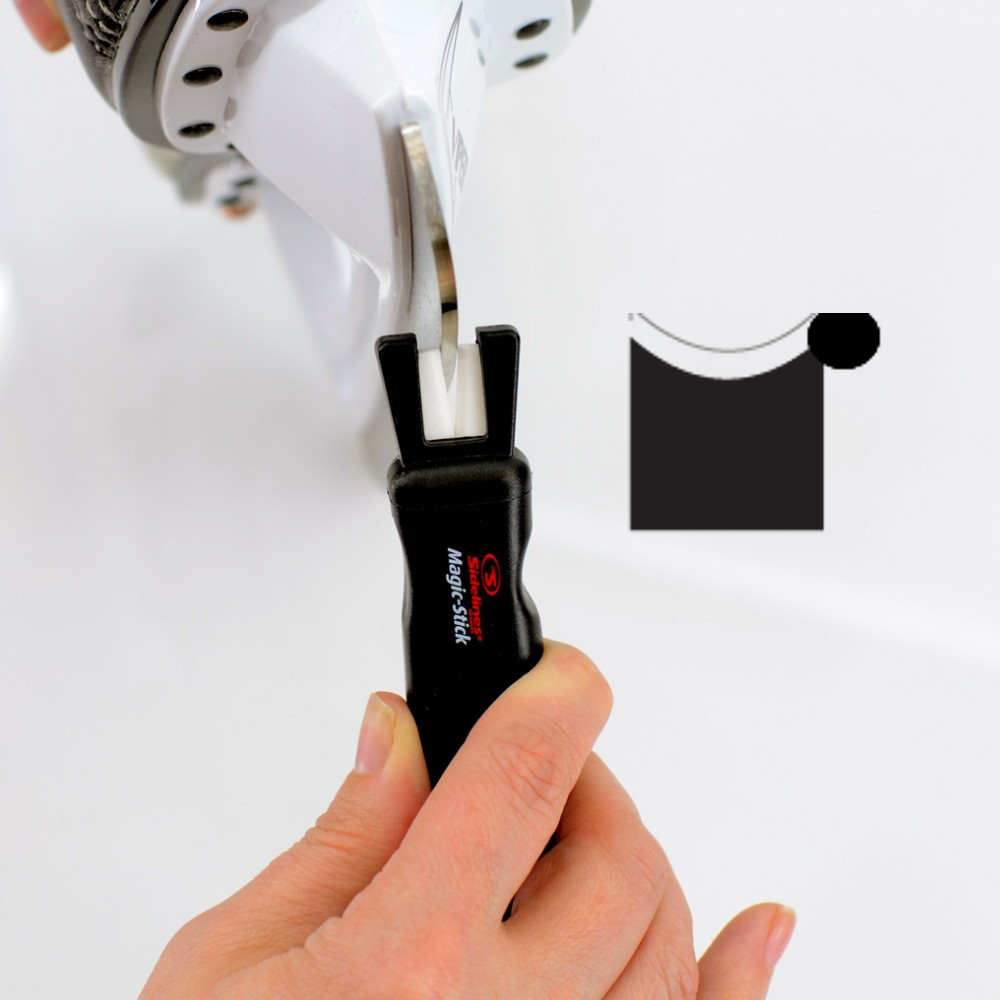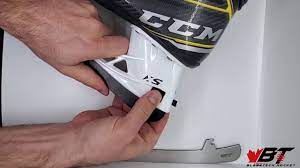Yes. Sharp skates on the store shelves could result in customers being injured. Besides the liability issue, eliminating skate sharpening saves a bit of money for the manufacturers.
Back to FAQsRules of thumb:

New skate runners are flat on the bottom. Sharpening removes steel from the centre of the runner to create an inside and an outside edge. To do this, the face of the sharpening stone is dressed to a particular radius measurement — the Radius of Hollow.

Many players use a 1/2 inch hollow, but others will prefer one between 3/8 of an inch and 5/8 of an inch. It is a personal preference and worth experimenting with to find what feels best. The compromise is always between speed and agility. Hollows of a smaller radius feel "sharper" and enhance agility, but hurt speed slightly. Hollows of a larger radius allow a bit more speed at the expense of agility. For players learning the skill of two-foot stops it sometimes helps to use a larger radius of hollow for a time, so the skates have less bite. But as they gain confidence and demonstrate ability to perform the skill the hollow should be returned to normal.
Back to FAQsTry different hollows on your skates and pick one that feels most comfortable to you. Most people stick with that for a lifetime. Asking the skater's height, weight, or position they are playing to determine a hollow to apply is not a good indicator. Other factors, such as the condition of the ice they will be skating on have much more impact. And changing the hollow frequently to account for a weight or position change will be frustrating. Keeping the feel of the edge consistent will allow the player to better adapt to changing ice, and growth.
Back to FAQsThe flat bottom sharpening method involves shaping the face of the sharpening stone to produce very aggressive edges.

The technique was first promoted by a company bringing a new skate sharpening machine to the market. It was novel and developed a following for a short time. More recently, scientific testing at the Brock University Skate Lab has determined there is not any measurable performance advantage for hockey players. I have equipment in my shop to do flat bottom, but choose not to use it. I tried it on my skates, and concluded there may be a detrimental impact on a hockey player's game performance. Also, the degree of precision required to produce this type of sharpening consistently is not easily attainable or replicated. And the thinness of the edge produced means it can be more easily damaged. If you choose to have this done to your skates be prepared to sharpen more frequently, and to deal with bad sharpenings more often.
Back to FAQsThe inside of skates is a perfect breeding ground for some nasty bacteria and fungii. If your skates are not cared for properly between ice times this will promote mould and mildew which will become a serious health hazard to anyone who comes into proximity of them. Follow these steps:
![]()
NOT a very good idea. That will just mask the odour, not deal with the cause. And it will not get underneath the insole where the issue begins. Also, chemical agents introduced into the closed space of a skate might result in a lot of foot irritation.
A little extra precaution you can take is to wear a pair of thin socks in the skates, and wash them after every skate.
Back to FAQsThis is an innovation that actually is more than a cosmetic marketing thing. That black stuff is not just paint, it is a carbon a micro-coating that supports the edges. They will stay sharper longer, unless the technician sharpening your skates uses a hone on them and removes the coating. Once the steel is exposed the protection is lost, but you can still use the runners like any other pair.
Back to FAQsThere is not much you can do to fix the edge that will not just make the situation worse. This is self-serving, I admit, but it cannot be helped. If you have the newer Bauer Edge trigger holder or CCM SpeedBlade thumbwheel on your skates the best remedy by far is a spare set of sharp runners that can be easily swapped on the bench. Even if your skates have CCM holders with a bolt at each end of the runner it is worth having the extra runners to use. It is a pretty quick job to swap them. Some Easton skates are similar. Grafs have a bolt you can access, but there are some tricks to changing those runners and I would not recommend trying in the middle of a game yourself. Those extra runners also mean you can use the skates outdoors then put the sharp set in before you play a game in an arena.

The ceramic tools that have become staples on the shelves of some sporting goods retailers help them, but will not do much for the player. They were created by the equipment manager of an NHL team as a quick fix at the end of the game when an edge is damaged and there is not time to run to the team training room to sharpen the skates for that last shift. When abused, that tool actually weakens the steel by folding the edges over, and it turns a proper runner edge that has a bite angle on the inside of the hollow into a knife edge beveled on both sides, which is very difficult to skate on. Well meaning trainers and coaches have left players stuck in the ice unable to do much of anything. Fixing the skates later will require the sharpening technician to remove a lot of steel that need not have been sacrificed. If you want to use something, a simple honing stone that can remove the burrs left by an accident is often enough to get you to the end of the game. Just make sure the stone is held flat against the side of the runner, not angled as it would be when sharpening a knife.
Back to FAQs

Skate sharpenings can be afflicted with a lot of different issues, mostly as a result of lack of attention by the technician or lack of proper training in the first place, or poorly set-up equipment. A common fault occurs when the runner is not properly centered on the face of the stone. This produces one of three results:
Chattering occurs when the edge being stopped on (inside or outside) has too much bite. Sometimes the radius of hollow is too small for the player, or "too sharp." More often it is because the skate was not centered on the sharpening stone resulting in one edge being "higher" than the other. Sharpening your skates properly, maybe at a slightly larger radius of hollow so you do not dig into the ice as much, will fix this problem.
Back to FAQsWhen enough of the steel gets ground off in sharpenings, the skate cannot be clamped in a sharpening vise without compromising the vise. That is going to happen when there is about 7 or 8 mm of steel left protruding from the plastic holder in the centre of the runner. But if the runner toes and heels are ground away creating "banana blades," your skates may be wasted before they reach the limit of the steel in the centre.
Back to FAQsUsually this is simply because the bolts holding the runners in place have loosened slightly. On many skates it is a quick fix to tighten the bolts. Newer Bauer and CCM skates have triggers or locking wheels that permit quick runner swaps. Over time these seem to work loose at the prong near the toe of the runner. Try wrapping a bit of tape over it then installing the runner again. On older Bauer skates though, the runner mounting system is located inside the plastic runner holder, and this repair will take longer and sometimes requires taking the whole holder off the boot and remounting it. Some skates do not have a runner mounting mechanism at all, the runners are incorporated into the holders in the plastic moulding process and there isn't anything to be done if they work loose.
Back to FAQs